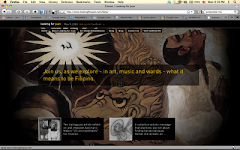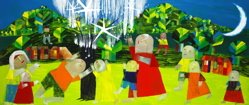
CANVAS thanks Katrina Stuart Santiago for her very frank and reasonable critique of our latest children's book. While we don't agree with all her points, it is one of the few reviews that actually gave us pause, and one which will only help us as we publish more children's books in the future.
================================
Colorful jeepney takes grand ride in children’s book
By Katrina Stuart Santiago
Philippine Daily Inquirer
The jeepney driven by Mang Tomas is central to the community’s migrations and returns, its celebrations and daily living, its dependence on a movement that’s personal and economic. More than anything, it turns out to be the story of a family, and how the birth of a young boy at Christmas time brought this family luck, contentment and happiness. One story that becomes the little boy’s own aspirations, as he plays driver, rides the jeepney, and dreams of becoming his father.
Anthony E. Palomo’s paintings capture perfectly this community’s life and color. Browns, reds and yellows create the image of a small provincial town in the Philippines that seems content and laid-back, but is obviously alive and productive. In Palomo’s hands, the paintings of the community are about emotions; it is about the few faces that Palomo makes visible in the midst of a blur: A woman’s smile of relief as she reunites with her family (“Saksi sa Pag-alis at Pag-uwi”); laughter between Mang Tomas and his son (“Ama at Anak: Tawanan”); an old lady’s toothy smile (“Lola”) on the page that speaks of the community’s love for Mang Tomas; and a couple in conversation (“Kuwentuhan”).
The blurred lines and faces of Palomo’s paintings here highlight instead captured movements and moments: The working barber and farmer (“Barbero” and “Pagtatanim”); the moving jeepney (“Mahusay”); Mang Tomas’ hand on the protagonist’s head (“Ama at Anak: Lambing”); Mang Tomas and his pregnant wife in the jeepney (“Simbang Gabi”); Mang Tomas cuddling a baby (“Ama at Anak: Simbang Gabi”); and the protagonist pretend-driving the jeep looking to a sunrise (“Balang Araw”).
These moments in the community’s and Mang Tomas’ family’s lives are rendered as if they are pregnant with hope, given Palomo’s colors and his broad strokes that allow for seeming movement and possibility. Between Palomo’s paintings and Cruz’s story, nothing could possibly go wrong for “Ang Dyip ni Mang Tomas.” But sadly, there is the book design and layout to talk about, as well as the translation.
Heidi Emily E. Abad’s English translation of Cruz’s original is beautiful. The thing is, for a translation, it also loses much of the original, seemingly creating a different story altogether that’s for a reader of another age bracket. For a children’s book, the faithfulness of the translation to the original text is crucial, since it could be a pedagogical text for a young reader.
This same reader is also what a book designer would consider, yes? It is easy to imagine fonts, text boxes and colors as irrelevant until you encounter a book like this one. With Palomo’s paintings in deep hues of reds and yellows, it was surprising to see no white pages just filled with text to counter these colors. Instead, much of “Ang Dyip ni Mang Tomas’” pages are filled with Palomo’s paintings, and are disturbed either by text boxes or by text-filled pages in the strangest of dark hues of aqua blue, lavender, ochre, apple green and peach. With a consistent black font for the text, it is impossible to see this as reader-friendly, less so for young readers’ eyes.
But maybe the book’s cover should’ve been indication enough of where “Ang Dyip ni Mang Tomas” falters. The book’s jacket is unexciting and barely interesting, as it spreads across the front and back one of Palomo’s jeepney paintings. This wouldn’t be so bad had the book’s real cover been exactly the same, but it isn’t. Instead, the book’s front and back cover are Palomo’s “Ama at Anak: Simbang Gabi” and “Mahusay,” respectively, both of which capture exactly what is central to Cruz’s story: A father and son who live off of, by and through a jeepney that allows a whole community to live as well.
That this might be lost in translation (and book design), is a sad, sad thing. But then again, at least this Canvas Story has the original text and artwork to fall back on.





No comments:
Post a Comment